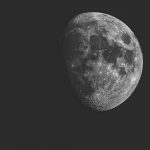New Study Suggests The End of the Lunar Dynamo Happened 1B Years Ago
The moon is known to have likely lost its magnetic field after an internal dynamo stopped firing, the question has remained, however, of when. A team led by Said Mighani from MIT’s Department of Earth, Atmospheric, and Planetary Sciences, and Huapei Wang from the China University of Geosciences, have been studying the moon’s magnetic field for several years, and think they found an answer.
The Original Findings
In a previous study done by the same team, samples indicate that the Moon generated a dynamo magnetic field around 4 billion years ago with the moon’s magnetic field being around 100 microteslas at this time. In 2017, new evidence was found suggesting that by 2.5 billion years ago, the magnetic field dropped to 10 microteslas.
The Answer We’ve Been Waiting For
In the team’s newest study, published in Science Advances, they looked at rocks from Earth’s lunar satellite and Apollo 15 mission. They studied the paleomagnetism of the young Apollo 15 breccias, 15465 and 15015, cooled in a near-zero magnetic field. This took place in the Massachusetts Institute of Technology (MIT) Paleomagnetism Laboratory using a 2G Enterprises superconducting rock magnetometer (SRM), focusing on the matrix glass.
These results showed the rocks dated back 1 B years and had significantly weak magnetic fields, with a recording of only .1 microteslas. These findings, combined with previous paleointensity estimates, indicate that the lunar dynamo likely ceased between 1.5 and 1 billion years ago.
Why This Is Important
The time of the dynamo’s cessation has major implications for the mechanism of magnetic field generation as well as the thermal and mechanical evolution of the lunar interior. Though this is a big finding, we still don’t have all the answers we need.
The team says more research will be needed to know if the dynamo stopped permanently or if it entered a “stop-start regime” before eventually ceasing. Also, they’re hoping to go beyond measuring the strength of the moon’s magnetic field from the samples and instead see if they can measure the direction of the field.
Discover More With Apex Magnets Today
New samples may be possible soon as NASA stated that they plan to build on Apollo’s missions by landing a new generation of U.S. astronauts, including the first woman, on the Moon by 2024. To stay up-to-date on this story and others like it, subscribe to our monthly newsletter.

